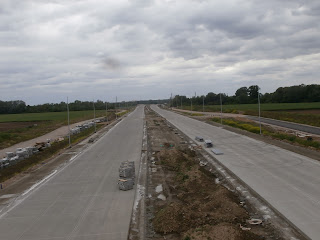The first comprehensive trip to inspect the progress of works on POW
construction west of Vistula since early-January foray. Last Sunday I made use
of loosening face covering obligations and cycle without a mask to check how
the works have moved on.
Sadly, the Warsaw town hall and GDDKiA have not reached an agreement on
closing the U-turn end of current POW, which could have been done just after
Easter, to benefit of sparse traffic at that time and day lengthening. The
deadlock results in total lack of connection between the current section of S2
and the one under construction.
I started off at the intersection of ul. Indiry Gandhi and ul. Płaskowickiej which
is an extension of Ursynów Zachód junction. The development is governed by the
City of Warsaw and unfortunately is botched up in terms of comprehensiveness. The
very intersection has multi-lane roads, while further west ul. Płaskowickiej is
narrowed down to one lane in each direction, which have been a bottleneck for
many years. The widened street would run just next to residential blocks by
roundabout where it crosses ul. Roentgena, but such proximity has not been a
hindrance for block north of the photographed intersection.
The roundabout at the intersection of ul. Płaskowickiej and ul. Pileckiego has been
restored, but traffic arrangement is temporary. Finishing works on the
southern, rebuilt lanes of ul. Płaskowickiej are being done. Over the last
weeks the photos have become outdated, since eastbound traffic has been partly
diverted into southern lanes.
The quirky traffic lights at the intersection of ul. Płaskowickiej,
ul. Stryjeńskich
and ul. Dereniowa have given way to a roundabout. Scrapped traffic lights have
put to an end post-pandemic traffic jams, yet another proof a roundabout
smooths traffic, provided drivers skilfully negotiate it. In the background,
the most renowned mural (building wall painting) in Ursynów, a tribute to
Stanisław Anioł, the main character of Alternatywy 4 TV series.
At Przyczyłkowa junction I cycled up the slip road to see the progress
on main roads of S2. No proper fence to keep visitors away, no security guard
to chase me away. The roads are made of huge concrete slabs, which ensures the
expressway will be more durable. Little is missing, crash barriers, the upper
abrasive layers of asphalt, curbs, lamp posts and marking out lanes.
I rode zigzags to reach ul. Syta which is already
carried above S2 by a nearly completed viaduct. From above one clearly sees
concrete slabs, packs of curbs awaiting laying and service roads before
asphalting. The expressway is actually passable for a passenger car. In the
distance, the tallest residential blocks in Ursynów.
A snap from the same location, looking towards Vistula. Works are done
even on Sundays (31 May being a Church festival as well), cranes facilitate
construction of the second most-complicated civil engineering object (the first
being the tunnel beneath Ursynów). I infer opening the section from ul.
Przyczółkowa towards A2 motorway east of Warsaw is conceivable this year.
The last picture taken from Wał Zawadowski. Drone photos much better
show the progress, from ground level one sees mainly mess close to the river.
In Poland pandemic has not slowed down works much, sadly it has not accelerated
them where necessary (at the hapless U-turn east of ul. Puławska).
Today I am finishing a fortnight holiday spent at home, reading, cycling
or helping my parents with overdue gardening. I had not felt tempted to go
anywhere. If epidemic indeed gets under control (the most recent data show
record-high number of new infections, most in one Silesian mine) I might
consider an away-from-home trip around late summer or early autumn.
Weather note (for Warsaw): May 2020 with average temperature of +11.9C
(vs. 1981-2010 average of +14.2C) was the coolest since 1992, the third coldest
in my lifetime. Monthly precipitation was 65.7 millimetres, vs. 1981-2020
average of 54.6 millimetres); along with recent rainfalls it temporarily gives relief
from drought. But globally it was the hottest May since records began. Central
Europe and central North America were the only cold spots on the map.








No comments:
Post a Comment